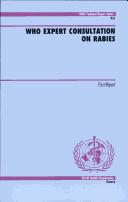| Listing 1 - 7 of 7 |
Sort by
|

ISBN: 9780123693662 0123693667 9780080550091 0080550096 Year: 2007 Publisher: London Elsevier/Academic
Abstract | Keywords | Export | Availability | Bookmark
 Loading...
Loading...Choose an application
- Reference Manager
- EndNote
- RefWorks (Direct export to RefWorks)
Rabies is the most current and comprehensive account of one of the oldest diseases known that remains a significant public health threat despite the efforts of many who have endeavored to control it in wildlife and domestic animals. During the past five years since publication of the first edition there have been new developments in many areas on the rabies landscape. This edition takes on a more global perspective with many new authors offering fresh outlooks on each topic. Clinical features of rabies in humans and animals are discussed as well as basic science aspects, molecular biology, pathology, and pathogenesis of this disease. Current methods used in defining geographic origins and animal species infected in wildlife are presented, along with diagnostic methods for identifying the strain of virus based on its genomic sequence and antigenic structure. This multidisciplinary account is essential for clinicians as well as public health advisors, epidemiologists, wildlife biologists, and research scientists wanting to know more about the virus and the disease it causes. * Offers a unique global perspective on rabies where dog rabies is responsible for killing more people than yellow fever, dengue fever, or Japanese encephalitis * More than 7 million people are potentially exposed to the virus annually and about 50,000 people, half of them children, die of rabies each year * New edition includes greatly expanded coverage of bat rabies which is now the most prominent source of human rabies in the New World and Western Europe, where dog rabies has been controlled * Recent successes of controlling wildlife rabies with an emphasis on prevention is discussed * Approximately 40% updated material incorporates recent knowledge on new approaches to therapy of human rabies as well as issues involving organ and tissue transplantation * Includes an increase in illustrations to more accurately represent this diseases' unique horror.
Rabies --- Rabies vaccines --- Rabies virus

ISBN: 0898383900 Year: 1988 Publisher: Boston (Mass.) : Kluwer,
Abstract | Keywords | Export | Availability | Bookmark
 Loading...
Loading...Choose an application
- Reference Manager
- EndNote
- RefWorks (Direct export to RefWorks)
Rabies in animals --- Rabies vaccines. --- Rabies virus. --- Rabies --- Rabies --- Rabies Virus. --- Rabies. --- Vaccination. --- Microbiology. --- Pathogenesis.
Book
ISBN: 9791032002834 Year: 2020 Publisher: Aix-Marseille : Presses Universitaires de Provence,
Abstract | Keywords | Export | Availability | Bookmark
 Loading...
Loading...Choose an application
- Reference Manager
- EndNote
- RefWorks (Direct export to RefWorks)
Cet ouvrage résolument interdisciplinaire rassemble des études au croisement des sciences médicales, biologiques et humaines, et permet d'éclairer des aspects méconnus voire totalement inédits concernant la rage. Cette maladie continue de tuer environ 50 000 personnes par an dans le monde alors qu'il existe un vaccin très efficace s'il est administré à temps. L'ouvrage débute par des données sur la rage en tant que maladie puis se divise en trois grandes parties. Il fait la part belle à l'Antiquité gréco-romaine, analysée sous l'angle philologique ainsi qu'à travers deux corpus (plinien et galénique). Des prolongements sur des périodes plus récentes permettent ensuite de retracer sur 2000 ans les manifestations de la rage furieuse qui pourraient être à l'origine de la légende des lycanthropes ainsi que les évocations d'un remède rappelant le principe de la vaccination. Cela permet d'établir, après analyse de milliers d'attaques d'êtres humains en France, une distinction nette entre loups prédateurs et enragés. Enfin, l'ouvrage se conclut par la biographie et l'évocation des travaux de trois personnages oubliés de l'histoire de la rage : le vétérinaire lyonnais Pierre-Victor Galtier qui a ouvert la voie à Louis Pasteur, le médecin Charles Livon à l'origine du centre d'inoculation antirabique de Marseille, et le microbiologiste Léon Perdrix, collaborateur de Pasteur et doyen de la Faculté des sciences de Marseille.
Rabies virus --- Zoonoses. --- Rabies Vaccines --- Rabies --- Virus rabique. --- Zoonoses. --- Vaccin antirabique. --- Rage --- history. --- Histoire. --- Pasteur, Louis

ISBN: 0120724014 0120724022 0323139701 1299443311 Year: 1975 Publisher: London Academic Press
Abstract | Keywords | Export | Availability | Bookmark
 Loading...
Loading...Choose an application
- Reference Manager
- EndNote
- RefWorks (Direct export to RefWorks)
Veterinary pathology --- Infectious diseases. Communicable diseases --- Rabies --- Rabies virus. --- -Rabies --- -Rabies in animals --- Veterinary virology --- Hydrophobia --- Lyssa --- Virus diseases --- Rabies viruses --- history. --- Epidemiology --- Pathogenesis --- Rabies in animals. --- Pathogenesis. --- History. --- Epidemiology. --- Rabies virus --- history
Book
ISBN: 3540571949 0387571949 Year: 1994 Volume: 187 Publisher: Berlin : Springer,
Abstract | Keywords | Export | Availability | Bookmark
 Loading...
Loading...Choose an application
- Reference Manager
- EndNote
- RefWorks (Direct export to RefWorks)
Rabies virus --- Rabiesvirus --- Virus de la rage --- Lyssavirus --- Rabies -- physiopathology. --- Rabies --- Physiology --- Physiopathology --- Prevention & control --- Physiology. --- Physiopathology. --- Prevention & control. --- Rabies -- physiopathology
Book
ISBN: 1487519834 1487519826 Year: 2020 Publisher: Toronto, Ontario ; Buffalo ; London : University of Toronto Press,
Abstract | Keywords | Export | Availability | Bookmark
 Loading...
Loading...Choose an application
- Reference Manager
- EndNote
- RefWorks (Direct export to RefWorks)
"Involved in rabies research for much of their working careers, editors Rowland Tinline and David Gregory explore Canada's unique contributions to rabies management in Taking the Bite out of Rabies. By placing the major players in rabies management from provincial and federal agencies, universities, and research institutions in historical context, Tinline and Gregory trace Canada's largely successful efforts to control rabies. Concerned about the loss of institutional memory that tends to follow success, Tinline and Gregory view this book as a crucial way to collate, verify, and preserve records for future understanding and research. The book maps the history of rabies across Canada and explores the science, organization, research, and development behind Canada's public health and wildlife vaccination programs. It also discusses how ongoing changes in agency mandates, the environment, and the evolution of the rabies virus affect present and future prevention and control efforts."--
Rabies --- Vaccination. --- Canada. --- Canada --- efforts to control rabies. --- history of rabies. --- public health and wildlife vaccination programs. --- rabies management in Canada. --- rabies virus. --- rabies. --- wildlife control.

ISBN: 9241209313 9786610436170 1280436174 9240681582 Year: 2005 Volume: 931 Publisher: Geneva
Abstract | Keywords | Export | Availability | Bookmark
 Loading...
Loading...Choose an application
- Reference Manager
- EndNote
- RefWorks (Direct export to RefWorks)
More than 99% of all human rabies deaths occur in the developing world, and although effective and economical control measures are available, the disease has not been brought under control throughout most of the affected countries. Given that a major factor in the low level of commitment to rabies control is a lack of accurate data on the true public health impact of the disease, this report of a WHO Expert Consultation begins by providing new data on the estimated burden of the disease and its distribution in the world. It also reviews recent progress in the classification of rabies viruses,
Hygiene. Public health. Protection --- Veterinary pathology --- Infectious diseases. Communicable diseases --- Rabies vaccines --- Rabies virus --- Rabiesvirus --- Virus de la rage --- Rabies --- Prevention and control --- Rabies vaccines. --- Hydrophobia --- Lyssa --- Virus diseases --- Viral vaccines --- Prevention.
| Listing 1 - 7 of 7 |
Sort by
|

 Search
Search Feedback
Feedback About UniCat
About UniCat  Help
Help News
News